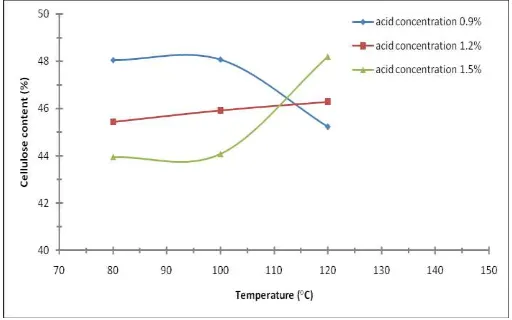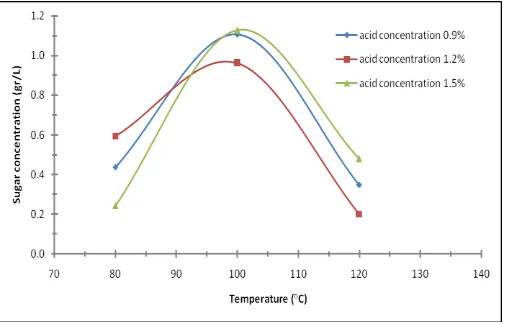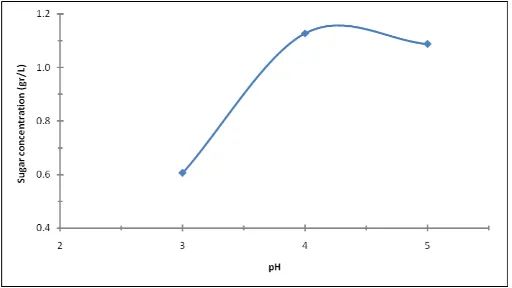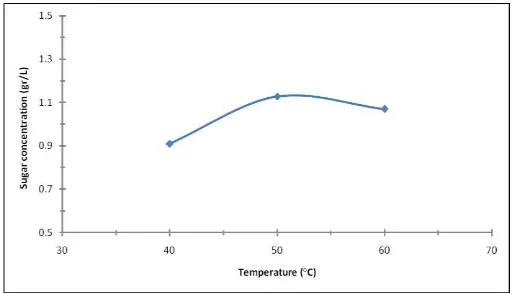Study of Enzymatic Hydrolysis of Dilute Acid Pretreated
Coconut husk is classified as complex lignocellulosic material that contains cellulose, hemicellulose, lignin, and some other extractive compounds. Cellulose from coconut husk can be used as fermentation substrate after enzymatic hydrolysis. In contrary, lignin content from the coconut husk will act as an inhibitor in this hydrolysis process. Therefore, a pretreatment process is needed to enhance the hydrolysis of cellulose. In this study, the pretreatment was done using dilute sulfuric acid in an autoclave reactor. The pretreatment condition were varied at 80°C, 100°C, 120°C and 0.9%, 1.2%, 1.5% for temperature and acid concentration respectively. The acid pretreated coconut husk was then hydrolyzed using commercial cellulase (celluclast) and β-glucosidase (Novozyme 188). The hydrolysis time is 72 hours and the operating conditions were varied at several temperature and pH. The highest sugar concentration (1.128 g/L) was obtained at pH 4 and 50°C which is pretreated at 100°C using 1.5% acid concentration.
Keywords: coconut, enzyme, hydrolysis, lignocellulose
1. Introduction
Lignocellulosic biomass is the most abundant renewable biomass on earth. This material consists of mainly cellulose, lignin, and hemicellulose. Cellulose and lignocellulose can be categorized as carbohydrate polymer. Carbohydrate polymer contains sugar units which is capable of being fermented into biohydrogen or other chemical. One of the most obtainable lignocellulosic biomass in Indonesia is coconut husk.
Coconut husk contributes 35% weight in coconut. Coconut husk is characterized as light, elastic, and water resistant. The coconut husk is composed of lignin (45.4%), cellulose (43.44%), pectin (3%), hemicellulose (0.25%) and ash (2.22%) [1].
This research investigates the production of the glucose solution through dilute acid pretreatment and enzymatic hydrolysis. Dilute acid pretreatment on coconut husk will support enzymatic hydrolysis process and enhance sugar production. The optimum operating conditions for overall process will also be determined.
2. Materials and Methods
2.1. Coconut Husk
The coconut husk used in the experiment was obtained from the nearest market.It was sun dried for about 1 day. The sun dried husk had length of 10-35 mm and diameter of 0.1-0.3 mm. In order to obtain better hydrolysis product, it was crushed using disk-milled FFC 23A (Shan Dong Ji Mo Disk Mill Machinery; 5800rpm; 3kW) and screened to achieve smaller size (70 mesh).
2.2. Pretreatment
2.3. Enzymatic Hydrolysis
Enzymatic hydrolysis was done by using the commercial endoglucanase enzyme (celluclast) and β-glucosidase enzyme (novozyme 188). The enzyme loading used was 15 FPU/g cellulose. The celluclast to novozyme 188 ratio was 2 FPU/CBU. The hydrolysis conditions was maintained at 40, 50, 60° C and pH of 3, 4, 5 using Na-citrate buffer. About 2 grams of the pretreated husk was mixed with 50 ml enzyme mixture containing Na-citrate buffer. The final mixture was then shaken in an incubator shaker at the speed of 90 rpm for 72 hours. The enzymatic reaction is then terminated by heating at 100°C for 5 minutes. The filtration was then performed using the filter paper. The reducing sugar content in the filtrate was then analyzed.
2.4. Analytical Method
Content of cellulose, hemicellulose, and lignin in the coconut husk were analyzed by using the Chesson method [2]. The sugar concentration of the hydrolysis product was analyzed by using DNS method [3].
3. Results and Discussion
3.1. Pretreatment
The delignification process affected cellulose yield significantly at higher temperature. The important results of delignification process were summarized in Figure 1 and Figure 2.
Figure 1. Lignin content in various delignification temperature and H2SO4 concentration
Figure 2. Cellulosecontent in various delignification temperature and H2SO4 concentration
saturated at 120°C. The reason of this probably was the low selectivity of delignification at 120°C. This could happen because of the longer retention time to reach 120°C [4]. The decreased cellulose yield could also happen because the acid favored the hydrolysis reaction better than delignification reaction. The hydrolysis reaction was accelerated by the increasing temperature[5].
On the other hand, at 1.2% acid concentration, the cellulose yield increased with temperature. The lignin temperature profile showed minimum yield at 100°C. The probable cause of this was the increased hemicellulose degradation or cellulose hydrolysis [4].
At 1.5% acid concentration, the higher temperature the higher cellulose yield could be obtained. The lignin yield at the varied temperature did not show significant change. This was probably because of slow delignification reaction, lignin condensation, or decomposition of other materials in coconut husk. The hydrolysis reaction in pretreatment can produce toxic by product. Those products can be in the form of furfural and hydroxymethyl-furfural [6].
3.2. Influences of Delignification Temperature and Acid Concentration in Enzymatic Hydrolysis
Firstly, hydrolysis process is performed on the same operating conditions at pH 4 and 50°C for 3 days (72 hours). This is done in order to find the best operating conditions of delignification process. The sugar concentration produced is presented in Figure 3-5.
Figure 3. Delignification temperature vs sugar concentration graphic
The enzymatic hydrolysis was also done on the untreated coconut husk. The reducing sugar produced was 0.171 g / L. From Figure 3 it can be seen that the acid pretreatment affected the hydrolysis reaction. Among the other pretreated husk hydrolysates, the sugar concentration produced from the untreated husk was the lowest. It is shown that the lignin inhibited the coconut husk hydrolysis.
From Figure 3 it can be seen that at 80°C the highest sugar concentration could be obtained at acid concentration of 1.2%. The delignification at 120°C produced the highest hydrolysate sugar concentration at 1.5% H2SO4. The delignification at 100°C also produced the highest hydrolysate sugar at 1.5% acid concentration. The
latter was the most optimum conditions of delignification process for enzymatic hydrolysis process
Based on Figure 3, the sugar concentration produced increased at 100°C and decreased at 120°C. This may occur for several reasons. Among other conditions, the temperature of 80°C gave the lowest result. It may be caused be the high lignin content which could inhibit the enzyme activity. At high temperature lignin could decomposed into aromatic compounds which inhibited cellulase enzyme activity [7]. There was possibility that there were a lot of inhibitor present at this temperature.
The best pretreatment conditions that could produce the highest hydrolysate sugar concentration was the acid concentration of 1.5% H2SO4 and temperature of 100° C. It can be concluded that the high sugar yield was not
only affected by the high levels of cellulose in the coconut husk, but also influenced by the lignin content and byproducts (aromatic compounds, polyaromatic, phenolics, and aldehydes), that could inhibit the rate of enzymatic cellulose hydrolysis. At the pretreatment condition of 1.5% acid concentration and 100°C, there was possibility that the rate of cellulose hydrolysis, delignification, and hemicellulose dissolution in the pretreatment process were almost equivalent. This resulted in high cellulose content in the coconut fiber with fewer amount of inhibitors.
3.3. Temperature and Initial pH Influence of Enzymatic Hydrolysis
Enzymatic cellulose hydrolysis is the degradation of cellulose to glucose [7]. The enzymatic reaction is very sensitive to changes in temperature and environment pH. Optimum pH and temperature of the enzyme is a condition in which its catalytic activity is maximum [8]. The best result of delignification process was selected to be hydrolyzed at various pH and temperature. The purpose of this step is to determine the optimum enzymatic hydrolysis condition. The experiments were conducted at temperature of 40°C, 50°C, and 60°C and pH of 3, 4, and 5. Figure 4 shows the sugar concentration produced by enzymatic hydrolysis of pretreated coconut husk at 50 ° C with various pH.
Figure 4. Sugar concentration at various pH hydrolysis
Figure 4 show that the result of enzymatic hydrolysis at 50°C has optimum pH of 4-5. This is caused by the enzyme equilibrium charge which gives that the optimum enzyme catalysis. The enzymes that are polypeptides (proteins) consisted of amino acid groups, which are positively charged (+) and negative (-). The equilibrium between the charged (isoelectric point) will lead to protein precipitation so that the enzyme activity is reduced. Each enzyme protein has a different equilibrium point. Enzyme will tend to charge positively or negatively on the state of the acid-base state, thereby changing the structure of the enzyme and its activity is reduced or even become inactive. Thus, the level of acidity (pH) can affect the activity of the enzyme degrades substrate [7].
Based on the literature, cellulase enzyme produced from Aspergillus niger has a optimum pH in range 4.6 to 6
[9]. While the composition of cellulase enzymes by Trichoderma reesei produced tends to produce cellulase near pH 4 [7]. From these, the possibility of optimum pH for enzymes used in these experiments is around pH 4-5. This supports the results of our experiments, where the pH optimum for the enzymatic hydrolysis process is at pH 4. The results of these experiments are presented in Figure 5.
Figure 5. Sugar concentration at various hydrolysis temperature
4. Conclusions
From the results we can conclude few things. First, the acid pretreatment of coconut husk at various temperature and acid concentration causes significant changes in the levels of cellulose, lignin, and hemicellulose. The delignification temperature variations exerted greater influence than the acid concentration. The pH and temperature of enzymatic hydrolysis using celluclast and Novozyme 188 have significant influence to the sugar concentration produced. The best operating conditions for acid pretreatment was at 100°C and 1.5% (w/v) H2SO4.
This conclusion was based on the sugar concentration obtained. The optimum enzymatic coconut husk hydrolysis was at 50°C and pH 4. The highest hydrolysate sugar concentration obtained in this study was 1.128 g / L.
Acknowledgement
The authors would like to acknowledge Surabaya University which had facilitated our research work.
References
[1] Rajan, A., Senan, R.C., Pavithran, C., Abraham, T.E., 2005. Biosoftening of Coir Fiber using Selected Microorganisms. Bioprocess Biosyst. Eng., 28, 165-173.
[2] Datta R. 1981. Acidogenic Fermentation of Lignocellulose-Acid. Biotechnology and Bioengineering, 23 : 2167-2170 [3] Miller, G.L., 1959. Use of Dinitrosalicylic Acid Reagent for Determination of Reducing Sugar. Analytical Chemistry, 31 :
426–428.
[4] Sjöström E., 1998. Kimia Kayu Dasar-Dasar dan Penggunaan. Gadjah Mada University Press.
[5] Zulfansyah, Susanto Herri. 1998. Pembuatan Pulp dari Tandan Kosong Sawir dengan Proses Asetat. In Proceeding : Fundamental dan Aplikasi Teknik Kimia.
[6] Harmsen P. F. H., Huijgen W. J., Bermudez L. M., Bakker R. R. C. 2010. Literature Review of Physical and Chemical Pretreatment Processes for Lignocellulosic Biomass. Energy Research Centre of The Netherlands. 10-013
[7] Sukadarti S., Kholisoh S. D., Prasetyo H., Santoso W. P., Mursini T.. 2010. Produksi Gula Reduksi dari Sabut Kelapa Menggunakan Jamur Trichoderma reesei. Pengembangan Teknologi Kimia untuk Pengolahan Sumber Daya Alam
Indonesia ISSN 1693 – 4393, Yogyakarta.
[8] Perry, R.H., D.W. Green. 1997. Perry’s Che i al E gi eers’ Ha d ook, 7th edition. McGraw-Hill, New York.
[9] Held, Paul. Enzymatic Digestion of Polysaccharides : Optimization of Polymer Digestion and Glucose Production in Microplates. Biofuel Research.



